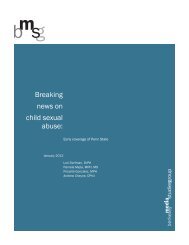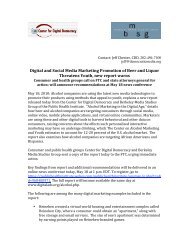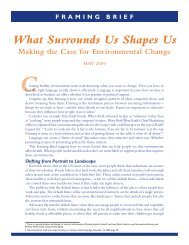Framing Brief_Soda_092309 - Berkeley Media Studies Group
Framing Brief_Soda_092309 - Berkeley Media Studies Group
Framing Brief_Soda_092309 - Berkeley Media Studies Group
Create successful ePaper yourself
Turn your PDF publications into a flip-book with our unique Google optimized e-Paper software.
Dale Kunkel, professor of communications at the University<br />
of Arizona and one of the nation’s leading researchers<br />
on children and media, was asked by Kolish to<br />
analyze food and beverage industry compliance. Kunkel<br />
is assessing compliance from February to May of 2008.<br />
“Given the stakes involved, the industry clearly needs<br />
to pick up the pace of its reform efforts,” Kunkel reports.<br />
“Thus far, the data reflect only a modest improvement<br />
in the nutritional quality of foods advertised to children.<br />
Advertising for unhealthy foods still predominates in the<br />
most recent studies examining food marketing to children.”<br />
61 (Kunkel has not separated soda producers from<br />
industry participants that produce food and soda.)<br />
Nutrition expert Nestle doubts Clinton’s school deal,<br />
the CBBB’s initiative or any self-regulation can protect<br />
children’s health.<br />
“There’s so much evidence that they’re only giving<br />
lip service to this,” she says. “They can’t do what they<br />
say, because they won’t sell products if they do. They’re<br />
not a public health agency. Either they have to go into<br />
another business or figure out some other way. They’re<br />
not going to sell healthy products to kids.” 62<br />
To Nestle, the Clinton alliance was “a way for soda<br />
companies to keep vending machines in schools.” Why<br />
are they selling water to kids in cities where water is free<br />
and good quality, she asks. “They’ve convinced people<br />
that the water from fountains is bad. Gatorade is still a<br />
soft drink with sugar that has nothing to do with sports<br />
and gives kids the idea that they have to eat and drink all<br />
the time.” The vending machines<br />
keep the brand in front of children<br />
and generate good feelings about the<br />
company.<br />
What do the experts think?<br />
In 2004, an American Psychological<br />
Association task force led by researcher<br />
Kunkel recommended that<br />
advertising targeting children under<br />
the age of 8 be restricted. After several years of research<br />
review, the team found that children under that age lack<br />
the cognitive development to understand the persuasive<br />
intent of television advertising and are uniquely susceptible<br />
to advertising’s influence. Children recall content<br />
from ads to which they’ve been exposed, according to<br />
the research, and preference for a product has been<br />
shown to occur with as little as a single commercial exposure<br />
and strengthened with repeated exposures. 63<br />
10<br />
Almost twice as many American<br />
children (2-11 years of age) are<br />
watching American Idol than<br />
SpongeBob SquarePants.<br />
“American Idol is a Coke ad,” says Kunkel.<br />
The Coca-Cola Company says it does not advertise<br />
to children under the age of 12 when they are 50% or<br />
more of the TV viewing audience. But according to<br />
Kunkel, that assertion is “grossly oversimplified “<br />
He says that the soda giant “is trying to say, ‘We’re not<br />
targeting ads in programs made exclusively for children.’<br />
But they’re implying that their advertising is not seen by<br />
substantial numbers of children, and millions of children<br />
see Coke ads every day.”<br />
The way soda companies reach children and teenagers<br />
is through family entertainment. Just ask Diana Garza-<br />
Ciarlante, communications director for Coca-Cola,<br />
North America.<br />
“Coca-Cola respects the sanctity of childhood,” she<br />
says. “With American Idol, the issue becomes a question<br />
of programming. This is family programming, on the air<br />
8 p.m. or later. Even at its height of Idol popularity, children<br />
under the age of 12 were 7 or 8% of the audience.<br />
Children are not alone. They’re not in a bubble. We need<br />
to be realistic … That said, we have a responsibility to<br />
present [the product] in a place appropriate to the brand.<br />
Family environments are appropriate. The expectation is<br />
that the parent or caregiver is making the decision<br />
whether or not it’s appropriate to be exposed to the programming.”<br />
64<br />
Garza-Ciarlante is correct about the percent of children<br />
in the Idol audience on average. But when accounting<br />
for the millions of children the percentage represents,<br />
almost twice as many American children<br />
(2-11 years of age) are watching<br />
American Idol than SpongeBob Square<br />
Pants.<br />
According to Anne Elliot, vice<br />
president of communications for The<br />
Nielsen Company, American Idol averaged<br />
29.4 million viewers during<br />
the 2007 season. 65 The age distribution<br />
shows that:<br />
■ American Idol averaged 2.3 million kids (2-11), which<br />
is 5.7% of all kids in TV homes.<br />
■ The show averaged 1.9 million teens (12-17), which<br />
is 7.5% of the teens in TV homes.<br />
■ It averaged 14.2 million adults (18-49), which is 11%<br />
of adults of those ages in TV homes.<br />
Elliot looked at SpongeBob during the week of April<br />
21, 2008, when there were 56 telecasts of the program:<br />
■ SpongeBob’s average kids (2-11) audience was 1.5 mil-









